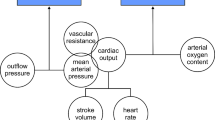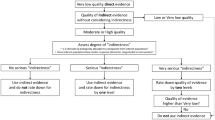Abstract
The study deals with an animal model for the problems of surgical intensive care patients. Following repeated applications of E. coli endotoxin W0111:134 under standard conditions, specific hemodynamic and biochemical (TNF, TXA2, PGI2, IL-6, PAF) and morphological (endothelium of the lung) alterations were detected. ARDS patterns induced by the sepsis were analyzed by high-frequency measurement of pressure and flow (385 measurements per breathing cycle). The role of the intestine in sepsis was investigated by ion-selective monitoring of surface potassium activity comparing mucosa and serosa. Every injection of endotoxin was followed by a selective increase of the potassium activity revealing relative ischemia induced by the endotoxin. The profile of the potassium levels on the surface correlates both with the cardiac output and with the prostacyclin levels. The continuous narrowing of the difference between mucosa and serosa, potassium during the period of investigation can be regarded as evidence for pathologic change in permeability fostering the septic course.
Zusammenfassung
Beschrieben wird ein tierexperimentelles Sepsismodell, das der Problematik chirurgischer Intensivpatienten entspricht. Nach rezidivierender Applikation von E.-coli-Endotoxin W0111:134 unter standardisierten Bedingungen konnten spezifische hämodynamische, biochemische (TNF, TXA2, PG I2, IL-6, PAF) und morphologische Veränderungen (pulmonales Endothel) nachgewiesen werden. Die sepsisinduzierten ARDS-Veränderungen werden mit einer Hochfrequenzdruck-und-flowmessung mit 385 Meßpunkten fiber einem Atemzyklus analysiert. Die Rolle des Darms in der Sepsis wurde mit ionenselektivem Kaliummonitoring vergleichend auf der Mukosa and Serosa untersucht. Jede Endotoxingabe wurde vom Dünndarm mit selektiven Anstiegen der Kaliumaktivität als Ausdruck einer Endotoxin-induzierten relativen Ischämie beantwortet. Das Profil der Oberflächenkaliumwerte korreliert sowohl mit dem „cardiaco output” als auch mit den Prostazyklinspiegeln. Die während der Versuchsdauer kontinuierlich abnehmende Mukosa-Serosa-Kaliumdifferenz kann als Nachweis einer die Sepsis katalysierenden intestinalen Permeabilitätsstörung interpretiert werden.
Similar content being viewed by others
Literatur
Aarden LA, De Groot ER, Schaap OL, Lansdorp PM (1987) Production of hybridoma growth factor by human monocytes. Eur J Immunol 17:1411–1416
Antonsson JB, Fiddian-Green RGAD (1991) The role of the gut in shock and multiple system organ failure. Eur J Surg 157:3–12
Ashbaugh DG, Bigelow DB, Petty TL, Levine BE (1967) Acute respiratory distress in adults. Lancet II:319–323
Bachofen M, Weibel ER (1974) Basic pattern of tissue repair in human lungs following unspecific injury. Chest 65 [Suppl] 65:14S-19S
Bachofen M, Weibel ER (1977) Alterations in the gas exchange apparatus in adult respiratory insufficiency associated with septicaemia. Am Rev Respir Dis 116:589–615
Baum M, Benzer H, Putensen H, Koller W, Putz G (1989) Biphasic positive airway pressure (BIPAP) — eine neue Form der augmentierenden Beatmung. Anaesthesist 38 (9):452–458
Benzer H, Koller W (1987) Beatmung — wohin geht die Entwicklung? Langenbecks Arch Chir 372:59–63
Brigham KL, Meyrick B (1986) Endotoxin and lung injury. Am Rev Respir Dis 133:913–927
Cannon JG, Tompkins RG, Gelfand JA, Michie HR, Stanford GG, Meer van der JWM, Endres S, Lonnemann G, Corsetti J, Chernow B, Wilmore DW, Wolff SM, Burke JF, Dinarello CA (1990) Circulating Interleukin-1 and tumor necrosis factor in septic shock and experimental endotoxin fever. J Infect Dis 161:79–84
Coalson JJ, Hinshaw LB, Guenter CA, Berrell EL, Greenfield LJ (1975) Pathophysiologic responses of the subhuman primate in experimental septic shock. Lab Invest 32:561–569
Cotran RS (1987) New roles for the endothelium in inflammation and immunity. Am J Pathol 129:407–413
Craig I, Judges D, Gnidec A, Lefcoe M, Paterson N, Finley R, Sibbald W (1987) Pulmonary permeability edema in a large animal model of nonpulmonary sepsis. Am J Pathol 128:241–251
Cunningham AL, Hurley JV (1972) Alpha-naphthyl-thiourea-induced pulmonary oedema in the rat: a topographic and electron microscope study. J Pathol 106:25–35
Danzmann E, Voigt H, Harzendorf E, Bomm M (1989) Anwendung einer Hochfrequenz-Beatmung bei Patienten mit respiratorischer Insuffizienz. Z Erkr Atmungsorgane 172 (3):299–305
Dinarello CA (1988) Biology of Interleukin O. FASEB 2:108–115
Doebber TW, Wu MS, Robbins JC, Choy BM, Chang MN, Shen TY (1985) Platelet-activating factor (PAF) involvement in endotoxin-induced hypotension. Studies with PAF receptor antagonist kadsurenone. Biochem Biophys Res Commun 127:799–808
Fenzlein PG, Abendroth D, Schilling M, Pfab W, Land W (1989) A new bio-chemical multisensorelement for measurement of organ viability. Abstract 4th International Symposium on Organ Procurement and Preservation
Fitzpatrick FA (1978) A radioimmunoassay for thromboxane B2 in the dog. Circ Res 44 (6):748–751
Flohe' L, Giertz H (1988) Endotoxins, arachidonic acid and superoxid formation. In: Urbascheck B (ed) Perspectives on bacterial pathogenesis and host defense. pp 123–131. Chicago Univ Press, Chicago
Fritz H, Jochum M, Daswald KH, Dittmer H, Kortmann H, Neumann S, Lang H (1986) Granulocyte proteinases as mediators of unspecific proteolysis in inflammation. In: Tschesche H (ed) A review in proteinases in inflammation and tumor invasion. de Gruyter, Berlin, pp 1–23
Gattinoni L, Pesenti A, Avalli L, Rossi F, Bombino F (1987) Pressure-volume curve of total respiratory system in acute respiratory failure. Am Rev Respir Dis 136:730–736
Gattinoni L, Pesenti A, Bombino M, Baglioni S, Rivolta M, Rossi F, Rossi G, Fumagalli R, Marcolin R, Mascheroni D, Torresin A (1988) Relationships between lung computed tomo graphic density, gas exchange, and PEEP in acute respiratory failure. Anesthesiology 69:824–832
Haak CE, De Groot ER, Felt-Bersma JR, Nuijens JH, Strack van Schijndel RJM, Erenberg-Belmer AJM, Thijs LG, Aarden LA (1989) Increased plasma levels of Interleukin-6 in sepsis. Blood 74:1704–1710
Hangen DH, Bloom RJ, Stevens JH, O'Hanley P, Ranchod M, Collins J, Raffin TA (1987) Adult respiratory distress syndrome — a live E. coli septic primate model. Am J Pathol 126: 396–400
Haselton PS (1983) Adult respiratory distress syndrome — a review. Histopathology 7:307–332
Haselton PS, Penna P, Torry J (1981) Effect of oxygen on the lungs after blast injury and burns. J Clin Pathol 34:1147–1154
Hauss J, Pichlmayer R (1991) Posttraumatisches akutes Lungenversagen. Behandlung durch drucklimitierte Beatmung und kontinuierlichen Lagewechsel. Dtsch Med Wochenschr 23; 116 (34):1257–1264
Hensby CN, Jogee M, Elder MG (1981) A comparison of the quantitative analysis of 6-oxo-PGF1 in biological fluids by gas chromatography, mass spectrometry, and radioimmunoassay. Biomed Mass Spectrom 8 (3):111–117
Lefer AM (1989) Significance of lipid mediators in shock states. Circ Shock 27:3–12
Lung program, National Heart and Lung Institute (1972) Respiratory diseases: Task forces on problems, research approaches and needs. Washington, D.C.: Government Printing Office, 171 [DHEW pub. no. (NIH) 73–432]
Meyrick B, Johnson JE, Brigham KLAD (1989) Endotoxin-induced pulmonary endothelial injury. Prog Clin Biol Res 308:91–99
Oettinger W, Walte GO, Jensen UM, Beyer A, Peskar A (1983) Endogenous prostaglandin F2 in the hyperdynamic state of severe sepsis in man. Br J Surg 70:237–239
Pearson FC, Dubczak J, Weary M, Bruszer G, Donohue G (1985) Detection of endotoxin in the plasma of patients with gram-negative bacterial sepsis by the limulus amoebocyte lysate assay. J Clin Microbiol 21 (6):865–868
Peitzman AB, Udekwu AO, Ochoa J, Smith SAD (1991) Bacterial translocation in trauma patients. J Trauma 31:1083–1087
Pichlmayr I, Pohl S, Knitsch W, Schultz A (1991) Kann die Beatmung nach dem Prinzip der “Eisernen Lunge” heute eine Zusatz- bzw. Alternativmethode zur konventionellen Beatmungsform darstellen? Anaestesist 40 (1):39–46
Ramsay G, Newman PM, McCartney AC, Ledingham IM (1988) Endotoxemia in multiple organ failure due to sepsis. Prog Clin Biol Res 272:237–246
Reidy MA, Schwartz SM (1983) Endothelial injury and regeneration — IV. Endotoxin: A nondenuding injury to aortic endothelium. Lab Invest 48:25–34
Rinaldo JE, Rogers RM (1982) Adult respiratory distress syndrome. N Eng J Med 306 (15):900–907
Rixen H, Klosterhalfen B, Pennartz G, Teniz A, Schulz M, Kirkpatrick CJ (1990) Injury to endothelial cells and decrease of proliferation during the course of septic shock. Int Care Med 16:34
Schöffel U, Kopp KH, Manner H, Vogel F, Mittermayer C (1982) Human endothelial cell proliferation inhibiting activity in the sera of patients suffering from “shock” or “sepsis”. Eur J Clin Invest 12:165–171
Schwartz SM, Benditt EP (1977) Aortic endothelial cell replication. I. Effects of age and hypertension in the rat. Circ Res 41:248–256
Snedegard G, Lui L, Hugh TE (1989) Endotoxin induced shock in the rat. A role of C5a. Am J Pathol 135:489–497
Stevens JH, Raffin TA (984) Adult respiratory distress syndrome: I. Aetiology and mechanisms. Postgrad Med J 60: 505–513
Stevens JH, Raffin TA (1984) Adult respiratory distress syndrome: II. Management. Postgrad Med J 60:573–576
Strieter RM, Lynch JP, Basha MA, Standiford TJ, Kasahara K, Kunkel SLAD (1990) Host responses in mediating sepsis and adult respiratory distress syndrome. Semin Respir Infect 5:233–247
Templeton CB, Bottoms GD, Fessler JF, Turek JJ, Boon GD (1985) Effects of repeated endotoxin injections on prostanoids, hemodynamics, endothelial cells, and survival in ponies. Circ Shock 16:253–264
Thulig B, Hachenberg T, Wendt M, Wiesmann W, Sulkowski U (1991) Beatmung in Bauchlage beim akuten Lungenversagen. Anaesthesiol Intensivmed Notfallmed 26 (4):196–198
Tomashefski JF, Davies P, Boggis C, Greene R, Zapol WM, Reid LM (1983) The pulmonary vascular lesions of the adult respiratory distress syndrome. Am J Pathol 112:112–126
Tons C, Fenzlein PG, Winkeltau G, Büsser T, Schumpelick V (1991) Ionenselektives on-line Monitoring der Kalium-Aktivität als Parameter für die Dünndarmischämie. Langenbecks Arch Chir 271–275
West RL, Elovitz MJ, Hardaway RM (1966) Blood coagulation factors activity in experimental endotoxemia. Ann Surg 163:567–572
Worthen GS (1987) Lipid mediators, neutrophils, and endothelial injury. Am Rev Respir Dis 136:455–458
Author information
Authors and Affiliations
Rights and permissions
About this article
Cite this article
Töns, C., Klosterhalfen, B., Klinge, U. et al. Septischer Schock und multiples Organversagen in der chirurgischen Intensivmedizin. Langenbecks Arch Chir 378, 217–232 (1993). https://doi.org/10.1007/BF00184364
Received:
Issue Date:
DOI: https://doi.org/10.1007/BF00184364




